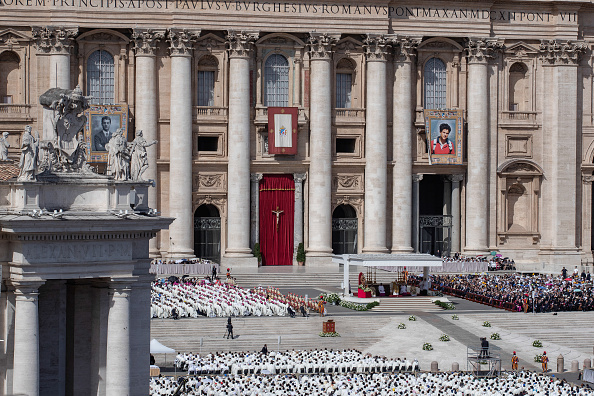As organized religions struggle to remain relevant in this increasing secular world, they must find ways to expand their numbers without alienating their base.
It seems that in his short reign, the new American pope of the Roman Catholic Church has managed to do both.
In declaring a 15-year-old Italian computer whiz the Church’s first millennial saint, Chicago-born Pope Leo XIV has given the next generation of Catholics a relatable role model who earned the nickname “God’s influencer” by using technology to spread the Catholic faith.
The pope recently canonized Carlo Acutis, who died in 2006, during an open-air Mass in St. Peter’s Square before an estimated 80,000 people, many of them millennials and couples with young children.
During the first saint-making Mass of his pontificate, Leo also canonized another popular Italian figure who died young, Pier Giorgio Frassati.
Leo said both had created “masterpieces” out of their lives by dedicating them to God. “The greatest risk in life is to waste it outside of God’s plan,” Leo said in his homily.
Acutis was born on May 3, 1991 in London to a wealthy but not particularly observant Catholic family. They moved back to Milan soon thereafter, where it’s said he enjoyed a typical, happy childhood, one marked by increasingly intense religious devotion.
Acutis was particularly interested in computer science, devouring college-level books on programming even as a youngster.
He earned the nickname “God’s Influencer” thanks to his main tech legacy: a multilingual website documenting Eucharistic miracles recognized by the Church, a project he completed at a time when web development remained the domain of professionals.
Acutis limited himself to an hour of video games a week, apparently deciding long before TikTok that human relationships far exceeded virtual ones.
That discipline and restraint has proved appealing to the Catholic hierarchy, which has emphasized the dangers of today’s tech-driven society.
In October 2006, at age 15, Acutis fell ill with what was quickly diagnosed as acute leukemia. Within days, he died. He was entombed in the Umbrian town of Assisi, known for its association with another popular saint, St. Francis.
In the years since his death, young Catholics have flocked by the millions to Assisi, where they can see the young Acutis through a glass-sided tomb, dressed in jeans, Nike sneakers and a sweatshirt.
He seems asleep, and questions have swirled about how his body was so well preserved, especially since parts of his heart have even toured the world as relics.
Both saint-making ceremonies had been scheduled for earlier this year, but were postponed after Pope Francis’ death in April.
Francis had fervently championed Acutis’ sainthood, convinced that the church needed someone like him to attract young people to the Catholic faith while addressing the promises and perils of the digital age.
Being a vigorous, worldly, soon-to-be 70-year-old — young by papal standards — Pope Leo obviously concurred with his predecessor’s assessment.
MBTA free-loaders not paying fair share
Forget the Charlie Card, riders on some MBTA subway and trolley lines must be flashing get-out-of-paying-fare cards.
That’s the takeaway from what Inspector General Jeffrey S. Shapiro has observed from the T’s ineffectual efforts to crack down on fare scofflaws.
A Shapiro-sent missive Monday to MBTA GM Philip Eng praised his newly launched effort to target fare evaders, while emphasizing the need to prioritize more effective fare collection on all modes across the entire system.
“I want to remind the MBTA’s leadership that there is a difference between someone who actively avoids paying the fare and a system that makes it easy to ride without paying,” IG Shapiro said. “The MBTA’s focus on fare evasion, must not detract from efforts to actively collect fares on both the commuter rail and the subway system every day.”
It seems that to date, the T has failed miserably on both counts.
IG Shapiro noted that since 2022, after the MBTA’s Board of Directors adopted new fare-enforcement policies, the T hasn’t issued a single warning or non-criminal citation. That’s despite the fact that it hired fare-engagement representatives in October 2024, a staff that’s grown to 19 whose collective salaries total around $2 million annually.
That’s a whole lot for a whole lot of nothing.
“I stress the importance of the MBTA prioritizing fare collection at the street-level stations where fare collection is the weakest and to hold its commuter rail operator to the contractual terms for fare collection,” IG Shapiro said.”
He noted that as part of the Office of the Inspector General’s ongoing fare collection observations, his team noticed that from 79% to 100 % of morning commuters on the Green Line’s C and D branches serving Brookline and Boston didn’t pay a fare.
Considering all the resources expended on updating subway cars and infrastructure to 21st-century standards, it doesn’t seem too much to ask that riders who benefit from these improvements pay a portion of that expense.
“While fare revenue will not solve the MBTA’s financial challenges, a demonstrated effort to both collect and enforce fares on all modes and routes will provide the public with a greater level of assurance as to how the MBTA treats public dollars.”
Well, we know how they’re treated currently, with disdain and indifference.
